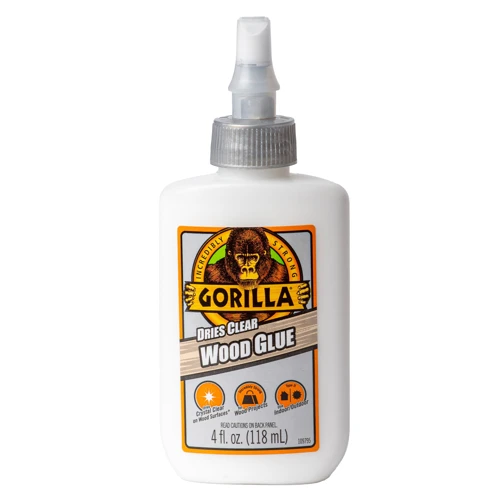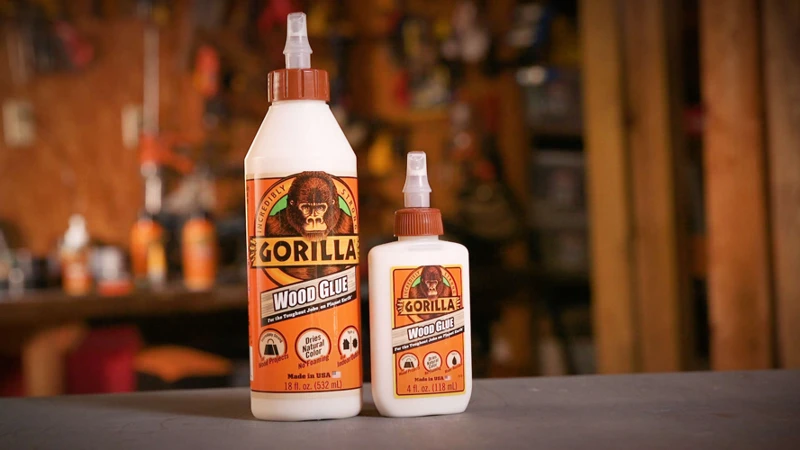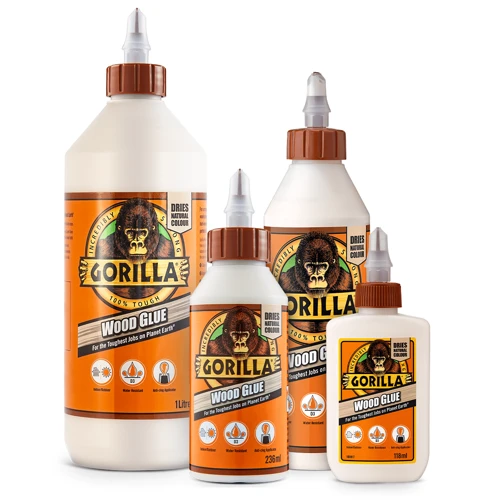You’re in the middle of a project, but your Gorilla wood glue seems too thick to work with. You can feel your anxiety levels rising, wondering what to do next. Don’t worry, thinning your Gorilla wood glue is easier than you might think. We’re here to show you a step-by-step guide on how to thin Gorilla wood glue so you can continue working on your project with ease. Not only that, but we’ll also give you tips on when to thin the glue and what to do and not to do when working with it. Let’s dive in and solve your dilemma.
Why Thin Gorilla Wood Glue?
Have you ever struggled to apply Gorilla Wood Glue evenly or smoothly? Do you need to adjust the consistency for a particular project, but don’t know how? That’s where thinning Gorilla Wood Glue comes in. Whether you’re looking for better absorption and penetration into the wood or easier application, thinning your glue can be an effective solution. In this article, we’ll explore the benefits of thinning Gorilla Wood Glue, when and how to do it, and some helpful tips for working with the glue. And if you’re curious about other aspects of Gorilla Glue, check out why Gorilla Glue is so strong to learn more.
Benefits of Thinning Gorilla Wood Glue
Thinning Gorilla Wood Glue has several benefits that make it a popular choice among professionals and DIY enthusiasts alike. These benefits include:
| Benefits | Description |
| Better Penetration | Thinned Gorilla Wood Glue can penetrate deeper into the wood surface, resulting in stronger and more resilient bonds between wood pieces. |
| Faster Drying | Thinned Gorilla Wood Glue dries faster due to the reduced thickness of the glue. This helps speed up the overall woodworking process. |
| Cost-effective | By thinning Gorilla Wood Glue with water, consumers can make their glue last longer by using less and getting more from each bottle. |
| Better Flow | Thinned Gorilla Wood Glue flows more easily into tight spaces and hard-to-reach areas, ensuring complete coverage and stronger bonds |
| Stronger bonds | Thinning Gorilla Wood Glue can lead to stronger and more durable bonds between wood pieces due to better penetration and greater adhesion. |
If you’re interested in learning more about Gorilla Glue, check out who created Gorilla Glue.
How to Thin Gorilla Wood Glue?
Thinning Gorilla Wood Glue is an essential step in ensuring that it performs optimally. When it comes to woodworking, Gorilla Wood Glue is a popular choice for its strength and durability. However, in some instances, the glue may be too thick or viscous, making it difficult to apply evenly and may affect the quality of your work. Fortunately, thinning Gorilla Wood Glue is a simple process that can help solve these issues and ensure the best possible result. In this article, we will provide step-by-step instructions on how to thin Gorilla Wood Glue for a smoother and more efficient application.
What You’ll Need
When it comes to thinning Gorilla Wood Glue, you’ll need a few items to get started. The good news is that these items are readily available and you may even have them on hand. Here’s what you’ll need:
| Item | Purpose |
|---|---|
| Gorilla Wood Glue | To be thinned |
| Measuring Cup | To measure water to be added |
| Water | To thin glue |
| Stirring Stick | To mix glue and water thoroughly |
| Bowl or Container | To mix glue and water together |
It’s important to note that using the correct ratio of glue to water is crucial for the success of this process. Using too much water can make the glue too thin and ineffective, while not using enough water may not thin the glue enough, causing problems when applying it to your project. So make sure to follow the recommended ratio of glue to water for best results.
Now that you have the necessary items, let’s move on to the steps on how to thin Gorilla Wood Glue. If you need help determining whether your glue needs thinning, see the “Signs Your Glue Needs Thinning” section.
(Note: For information on melting Gorilla Glue, check out How to Melt Gorilla Glue).
Step 1: Preparation
To prepare the Gorilla Wood Glue for thinning, there are a few important steps you need to follow. Proper preparation ensures that the glue remains stable and effective after thinning. Firstly, gather all the necessary materials: Gorilla Wood Glue, a clean container, water, and a stir stick. Make sure the container and stir stick are clean and free of any debris.
Step 1: Pour the Gorilla Wood Glue into the container. The amount of glue you pour in will depend on the amount of glue you need for your project. Ensure you’re using enough Gorilla Wood Glue to cover the surface area, but not so much that it overflows from the container. It’s important to use the correct amount of water in relation to the amount of glue you are thinning. If you use too much water, it can weaken the adhesive strength, and if you use too little, it will not be as fluid as required. A general rule of thumb is to use a ratio of one part water to one part glue for optimal results.
Step 2: Add water. In order to thin the Gorilla Wood Glue, add the required amount of water into the container. Measure the water using a measuring cup or a scale to ensure that you use the correct amount. Slowly pour the water into the container, stirring constantly.
Step 3: Mix thoroughly. After pouring in the water, use the stir stick to mix the glue and water together thoroughly. You want to make sure the glue is evenly mixed, and there are no clumps or unmixed areas. A good way to check if your Gorilla Wood Glue is properly mixed is to inspect the texture. A smooth, runny consistency indicates that the glue has been mixed correctly.
Following these preparation steps correctly sets the foundation for the Gorilla Wood Glue to be successfully thinned out. By taking the time to ensure everything is in order, you’ll avoid complications throughout the process. With your glue properly thinned, you’ll be well on your way to completing your project with Gorilla Wood Glue.
If you’re unsure of when to thin Gorilla Glue, check out our article on How to Tell When Gorilla Glue is Ready to Harvest.
Step 2: Add Water
Adding water to Gorilla Wood Glue is a crucial step in thinning it down for use. Here are the detailed steps on how to add water properly:
- Step 1: Before adding water, make sure to shake the glue bottle well to mix the contents inside.
- Step 2: In a separate container, measure the amount of glue needed for the project. Then, add an equal amount of water to the glue.
- Step 3: Gently pour the water into the glue container or bottle, making sure not to create any air bubbles.
- Step 4: Using a stir stick, mix the glue and water thoroughly for at least 2 to 3 minutes. Be sure to scrape the sides and bottom of the container to ensure that all the glue and water are properly mixed.
- Step 5: Check the consistency of the glue. If it is still too thick, add a small amount of water and stir again until the desired consistency is achieved.
Remember to add just enough water to achieve the perfect consistency. Adding too much water can weaken the glue, making it less effective. Additionally, using tap water may affect the glue’s performance. It is best to use distilled water or boiled water that has been cooled down for this purpose.
To understand the signs that indicate the glue needs thinning, check out our section on “When to Thin Gorilla Wood Glue?“.
Step 3: Mix Thoroughly
Once you have added the water, it’s time to mix the glue thoroughly. Mixing the glue well will ensure that the water is evenly distributed, and the glue reaches the right consistency. First, take a stir stick or wooden dowel and insert it into the glue container. Then, mix the glue for at least 30 seconds. Make sure to scrape the sides and bottom of the container to ensure that all of the glue is mixed in.
It’s essential to mix the glue well to avoid any lumps or inconsistencies in the mixture. Make sure that the glue is completely smooth with no clumps or chunks. If you notice any lumps in the mixture, continue mixing until the glue is completely smooth.
Tip: It’s essential to mix the glue right before use because it tends to settle over time. If you let the glue sit for too long, it may begin to separate and become unusable.
Once you have mixed the glue thoroughly, you’re ready to use it for your projects. Remember to work quickly, as thinned Gorilla Wood Glue dries faster than unthinned glue. Additionally, make sure to clean up any excess glue immediately after use with a damp cloth.
Internal link: If you’re wondering what color Gorilla Glue dries, you can learn more in our article What Color Does Gorilla Glue Dry?
When to Thin Gorilla Wood Glue?
Knowing When to Thin Gorilla Wood Glue is crucial to its effectiveness. Over time, your glue may become thick and difficult to use, leading to imperfect or messy results. It is essential to thin your Gorilla Wood Glue when it becomes too viscous. In the following section, we will discuss the signs that your glue needs thinning and when you can apply it to your project. Keep reading to ensure your project’s success.
If you’re interested in the earnings of the infamous “Gorilla Glue Girl,” check out how much she made from the viral incident.
Signs Your Glue Needs Thinning
Signs Your Glue Needs Thinning
It is important to know when your Gorilla Wood Glue needs thinning. Below are some signs that indicate that your glue could benefit from thinning:
| Signs | Description |
| Difficulty spreading | If your glue is too thick, it may be difficult to spread and evenly coat the surface of your material. This can result in weak bonds or uneven drying. |
| Extended drying time | When your glue is not spread evenly, it can take an extended period of time to dry, which can affect the overall quality of your project. Thinning the glue can ensure even drying and a strong bond. |
| Clumping of glue | If you notice clumps in your glue, it may indicate that it is too thick to be applied correctly. Thin the glue to achieve a consistent texture throughout the mixture. |
| Incomplete bonding | If your material is not bonding properly, it may be an indicator that your glue is too thick. In this case, thinning the glue can improve the bond and provide a stronger hold. |
Remember that if you’re unsure whether your Gorilla Wood Glue needs thinning, it’s always better to err on the side of caution and thin it out. This can save you time and stress in the long run. If you’re curious about how much Gorilla Glue costs per ounce, you can check out our article “How Much for a Ounce of Gorilla Glue?” on our website.
Tips for Working with Gorilla Wood Glue
As with any adhesive, working with Gorilla Wood Glue requires a certain degree of skill and attention to detail. If you want to make sure you’re getting the most out of your glue and avoiding any potential pitfalls, here are some helpful tips to keep in mind. From dos and don’ts to best practices and techniques for optimal results, these tips will help you achieve the best outcome for your woodworking project.
Do’s
When working with Gorilla Wood Glue, there are several important things to keep in mind to ensure the best possible results. Here are some important Do’s to follow:
- Work in a well-ventilated area: Gorilla Wood Glue emits a strong odor when in use. It’s important to work in a well-ventilated area to avoid inhaling the fumes and potentially causing health issues.
- Use a clean workspace: Make sure your workspace is clean and free from debris or dust. Any particles that come into contact with your glue can affect its bonding effectiveness.
- Apply only to the surfaces you want to bond: Apply a thin and even layer of glue only on the surfaces you want to bond together. Over-applying the glue may cause it to take longer to dry and harden.
- Use clamps: Use clamps to hold the pieces of wood securely in place while the glue is drying. This will ensure a strong bond between the two pieces of wood.
- Sand the wood: Sanding the surfaces before applying the glue can promote better adhesion. This is especially important when working with rough or uneven surfaces.
- Follow the instructions: Always follow the instructions provided on the Gorilla Wood Glue packaging to ensure that you are using the glue correctly and getting the best possible results.
By following these Do’s, you can achieve consistent and reliable results when working with Gorilla Wood Glue. Additionally, it is important to keep in mind the Don’ts to avoid potentially damaging your project or compromising the effectiveness of the glue.
Don’ts
When working with Gorilla Wood Glue, there are certain things you should avoid doing to ensure the best results. Here are some “don’ts” to keep in mind:
- Don’t add too much water when thinning the glue. As we mentioned earlier, adding too much water can compromise the glue’s strength. Stick to the recommended ratio of 5% water for the best results.
- Don’t apply the glue in temperatures below 55°F (13°C). Doing so can cause the glue to take much longer to dry, and may compromise its strength.
- Don’t overapply the glue. Applying too much glue could cause excess squeeze-out, which can be difficult to clean up and may cause unsightly marks on your project.
- Don’t try to speed up the curing process by applying heat or other accelerants. Gorilla Wood Glue is designed to cure at room temperature, and adding accelerants could compromise its strength.
- Don’t use Gorilla Wood Glue for applications involving constant or prolonged water exposure. While the glue is water-resistant, it is not waterproof, and may break down over time if exposed to prolonged water exposure.
It’s important to follow these “don’ts” to ensure that your project turns out as good as it can be. Avoiding these common mistakes will help you achieve the best possible results when working with Gorilla Wood Glue.
Conclusion
In conclusion, thinning Gorilla Wood Glue can have a significant impact on your woodworking projects. It makes the glue easier to spread and penetrate into the wood’s pores, resulting in stronger joints. By following the simple steps outlined in this article, you can thin Gorilla Wood Glue with ease. However, it is essential to remember not to over-thin the glue, as it can negatively affect its strength.
To further improve your experience with Gorilla Wood Glue, we recommend following some helpful tips. Do allow sufficient drying time before handling the joints and clamping the workpieces in place. Don’t thin the glue too much or add water multiple times to the same batch, as this can reduce its strength.
If you have any other questions regarding Gorilla Wood Glue, be sure to check out our other articles on topics such as “How to Make Gorilla Glue Epoxy Dry Faster” or “Why Does Gorilla Glue Foam?” for additional information. Thank you for reading, and happy woodworking!
Frequently Asked Questions
Can I thin Gorilla Wood Glue with any type of water?
No, you should only use distilled water to thin Gorilla Wood Glue as tap water can contain impurities that may affect the glue’s performance.
What is the ideal ratio of water to Gorilla Wood Glue?
The ideal ratio is 5 to 10% water per volume of Gorilla Wood Glue. You should not exceed a 10% ratio as it can severely weaken the glue.
Can I store thinned Gorilla Wood Glue?
Yes, thinned Gorilla Wood Glue can be stored in an airtight container for up to 9 months. Remember to label the container with the date of the mixture.
Will thinned Gorilla Wood Glue take longer to dry?
Yes, thinned Gorilla Wood Glue will take slightly longer to dry than un-thinned glue. However, this depends on the ratio of water used and specific environmental conditions.
Can I use Gorilla Wood Glue on all types of wood?
Gorilla Wood Glue can be used on most wood types, but it’s important to test the adhesive on a small area first to ensure compatibility.
Can I sand Gorilla Wood Glue after it has dried?
Yes, Gorilla Wood Glue can be sanded after it has dried. It is recommended to allow the glue to dry completely before attempting sanding.
Can I use Gorilla Wood Glue on surfaces other than wood?
No, Gorilla Wood Glue is specifically designed for wood surfaces and is not recommended for use on other materials.
Does Gorilla Wood Glue dry clear or opaque?
Gorilla Wood Glue dries clear, making it ideal for use on visible surfaces and finishes.
Can I apply pressure to the glued surfaces while the glue is drying?
Yes, it is recommended to apply light pressure to the glued surfaces while the glue is drying. This will help to create a stronger bond.
Is Gorilla Wood Glue waterproof?
Yes, Gorilla Wood Glue is water-resistant and can be used for outdoor projects. However, it’s important to note that the adhesive is not completely waterproof and may not hold up under constant exposure to water.


